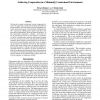Free Online Productivity Tools
i2Speak
i2Symbol
i2OCR
iTex2Img
iWeb2Print
iWeb2Shot
i2Type
iPdf2Split
iPdf2Merge
i2Bopomofo
i2Arabic
i2Style
i2Image
i2PDF
iLatex2Rtf
Sci2ools
AAAI
2008
2008
Achieving Cooperation in a Minimally Constrained Environment
We describe a simple environment to study cooperation between two agents and a method of achieving cooperation in that environment. The environment consists of randomly generated normal form games with uniformly distributed payoffs. Agents play multiple games against each other, each game drawn independently from the random distribution. In this environment cooperation is difficult. Tit-for-Tat cannot be used because moves are not labeled as "cooperate" or "defect", fictitious play cannot be used because the agent never sees the same game twice, and approaches suitable for stochastic games cannot be used because the set of states is not finite. Our agent identifies cooperative moves by assigning an attitude to its opponent and to itself. The attitude determines how much a player values its opponents payoff, i.e how much the player is willing to deviate from strictly selfinterested behavior. To cooperate, our agent estimates the attitude of its opponent by observing...
AAAI 2008 | Intelligent Agents | Normal Form Games | Simple Environment | Uniformly Distributed Payoffs |
Related Content
| Added | 02 Oct 2010 |
| Updated | 02 Oct 2010 |
| Type | Conference |
| Year | 2008 |
| Where | AAAI |
| Authors | Steven Damer, Maria L. Gini |
Comments (0)

